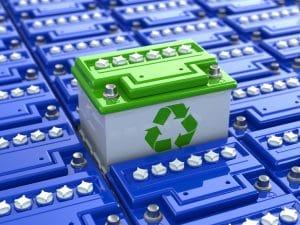The Indian automobile sector is one of the most prominent sectors of the country, accounting for nearly 7.1 percent of the national GDP.

The industry produced a total of 25.31 million vehicles, including commercial, passenger, two, and three vehicles and commercial quadricycle in April-March 2017, as against 24.01 million in April-March 2016. However, India has set itself an ambitious target of having only electric vehicles (EV) by 2030, which is expected to increase the demand for lithium-ion batteries in India, significantly. The high cost, associated with batteries that are used in the electric vehicles, is considered to be critical for India’s ambitious target. To counter this, the Government of India is planning to set up lithium-ion battery manufacturing units in India, aggressively. The leading business players in India, such as Adani, Suzuki, Reliance, IOCL, and JSW, are planning to acquire this growing opportunity and invest heavily in setting up of lithium-ion battery manufacturing units. Furthermore, factors, such as the growing adaption of smart grid initiatives and the implementation of lithium-ion-based energy storage system, are expected to support the demand for lithium-ion battery in the Indian market. The India lithium-ion battery market is expected to grow at a robust CAGR of 29.26 percent during the forecast period, 2018-2023.
Decreasing Cost of Lithium-ion Batteries – To Supplement the Demand
The high cost of lithium-ion batteries was considered earlier as one of the principal difficulties for the implementation of India’s ambitious all-electric vehicle target by 2030. However, boosted by the growing demand for electric vehicles across the globe, coupled with favorable government policies, is expected to reduce the costs of lithium-ion batteries in India, significantly. The costs of lithium-ion batteries have fallen drastically, from approximately USD 1000 per kWh in 2010 to USD 273 in 2016, and is expected to decrease further. Furthermore, the domestic production of lithium-ion batteries in the country is expected to increase during the forecast period, 2018-2023, supported by the planned establishment of domestic lithium-ion battery manufacturing units by various companies and government. Similar combined initiatives of the government and companies are expected to reduce the lithium-ion battery prices, and thus, in turn, increasing orders from the end-users during the forecast period.
Renewable-based Energy Storage – Opportunity for Growth
The Government of India is focusing on energy diversification and working hard toward its ambitious target of achieving 175 GW renewable capacity by 2022. The cumulative solar PV capacity in India grew past 10 GW – an approximately fourfold increase since May 2014 levels, with a further 14 GW pipeline projects knocking at the door, and an additional 6 GW to be auctioned soon. Similarly, the wind power capacity in the country is expected to be ramped up to 185 GW an eight-fold increase over 15 years from 2015, and to contribute approximately 14 percent of India’s renewable energy use. The implementation of large-scale implementation of renewable power in the country faces a significant hurdle of ramping and intermittency, which can be addressed by the widespread deployment of lithium-ion batteries as energy storage devices. In 2015, ACME, India’s leading energy management solutions provider, completed its first li-ion battery-based energy storage solution for a leading telecom tower company, which has resulted in the decline in the diesel consumption of the telecom tower, by approximately 40 percent to 60 percent. Encouraged by the results, similar projects utilizing lithium-ion battery-based energy solutions are expected to increase further, presenting an optimal opportunity for growth for the lithium-ion battery manufacturers and suppliers in India.
(Source: Market Insight Reports)




























